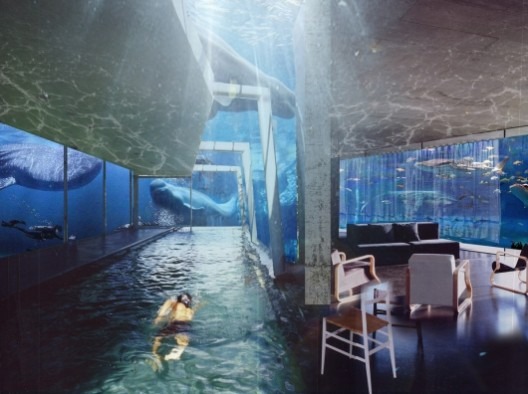The Berring Straits Project asked designers to imagine an element to connect the Russia and the United States. A peace bridge perhaps? Off Architecture were awarded second place for this imagining of a sometimes occupied space between two parallel 10 metre walls.
As architects contemplate the perils of global warming marine architecture is emerging as a serious discipline. However the genesis of this architectural discipline can be found in iconic structures such as the Miami Marine Stadium designed by Candela in the early 1960s. The stadium is expected to achieve landmark listing status.
Obviously, marine architecture presents a new challenge to the land-scape profession because imagining a sea-scape and the propogation of corals and algae in the enclosed gardens – hortus conclusus – of the ocean is conceptually different.
In the petrified seagarden, Richie Park, we are challenged to rethink our ideas about the natural boundaries between land and sea.
Yet, in explorations of the seaside, are potentially the sparks of inspiration for seagarden designers.


Apart from its economical use of land, I wonder how marine architecture rates in its overall use of resources. I can’t help thinking it makes extravagant use of embodied and disembodied energy. But perhaps it should be compared with coastal land – which tends to have higher ecological, visual, commercial etc values than interior land.
With all things in design the overall use of resources in a project can vary considerably.
[ http://s1.hubimg.com/u/388984_f520.jpg ]
For example is choosing timber:
What timber species? For what purpose? Are its qualities the most suitable given all the parametres? From where has it been sourced? Is the forest a potentially important sink/habitat? How is the forest managed? What are the labour and trade practices involved? How has the timber been harvested, handled and transported? What other alternatives were available? etc.
I don’t think the difference between the efficient use of resources and the use of renewable and recyclable resources has been made strongly enough.
Nor has the full resouce profile necessarily been considered within a cost/benefit analysis.
With coastal erosion and rising sea levels becoming more frequent sustainability problems, designing for a retreating shorelines and submergable structures might become increasingly viable.
It is also interesting to consider how the ancient Egyptians structured their working programme
(pyramid building/agriculture) around the cyclical flooding of the Nile.
Perhaps we could pay greater attention to the cycles of nature again within our designs rather than trying to smooth out environmental differences?
ps. http://eosweb.larc.nasa.gov/HPDOCS/misr/misr_images/nile_river.jpg
That is a very good point about coastal retreat, especially if it has to practiced on the scale of a country like Bangladesh. Also, the old walled cities of China functioned as flood-protection works in times of flood.
Your point about renewable resources extends to recyclable resources: perhaps we could find ways of recycling plastics to make the bouyancy sections of inhabitable islands. It would be better than landfill.
The Egyptians worked on temples on the edge of the flooded land during the season of inundation.